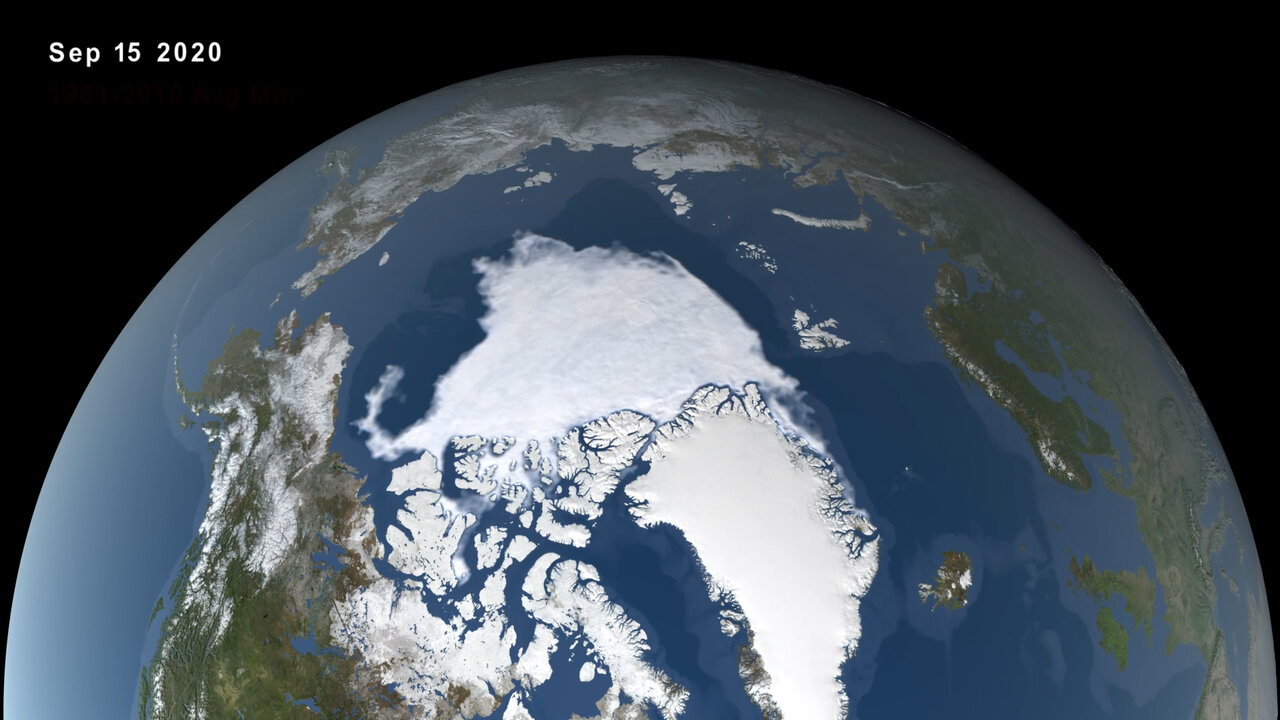This year the Arctic sea ice appeared to have reached its annual minimum extent of 1.44 million square miles (3.74 million square kilometres) in September 2020. This information was revealed by satellite data of NASA and the National Snow and Ice Data Centre (NSIDC) at the University of Colorado Boulder. It was the second-lowest mark after the satellite record in 2012. Following the minimum seasonal extent, which occurred on September 15, ice growth quickly began along the northern Beaufort, Chukchi, and East Siberian Seas. Expansion of the ice edge was also notable within the East Greenland Sea and within the Canadian Arctic Archipelago. The ice edge in the Kara and Barents Seas remained relatively stable until the end of the month when it expanded, and within the Laptev Sea, the ice edge retreated slightly. This year’s Arctic sea ice cover shrank to the second-lowest extent since modern record keeping began in the late 1970s.
Lets us understand what has been going on with the ice covers at the poles.
Since the beginning of the 1990s, many glaciers around the world are continually melting. From the industrial revolution, carbon dioxide and the greenhouse gases have raised temperatures, even higher at the poles, resulting in the rapid melting of glaciers, calving into the sea and retreating the land. The culprits? None other than us. Our greed has depleted everything that nature has blessed us with.
For understanding the melting of icecaps, take a quick look at this answer to the question:
Difference between sea ice and glacier?
Sea ice forms in the sea and melts strictly in it, whereas the glaciers form on the land. The chucks of ice, which get separated from the glaciers and fall into the sea, are called icebergs.
When the glaciers, formed from the water on the land fall off into the sea, eventually raise the water level in the ocean and rise in global sea water level.
Sea ice plays a role like ice in the glass of water. It directly does not change the water level in the glass, instead of the depleting ice caps in the sea act as a host for other devastating consequences such as the walrus and the polar bears.
What are the effects of melting glaciers on the sea-level rise?
We often think the melting glaciers add water in the sea level but massively affect the polar region. It increases coastal erosion and raises the storm surge as the warming air and ocean temperatures create typhoons and hurricanes in the coastal areas. The key areas in the Polar Regions, Greenland and the Arctic ice are the significant contributors to the sea level rise. The Greenland ice sheet is disappearing almost four times faster as compared to 2003. It already contributes 20% of current sea-level rise.
How much and how quickly these Greenland and Antarctic ice sheets melt will largely determine how much ocean levels rise. If emissions continue to rise, we expect the current rate of melting on the Greenland ice sheet to double by the end of the century. However, it can be extremely alarming for the earth as if all the ice on Greenland melted, it will result in raising global sea levels by 20 feet.
How sea ice and glaciers affect weather patterns?
Today the climatic conditions over the Polar Regions are frequently changing. On One hand, The Arctic is warming twice as fast as anywhere on earth while the sea ice is also declining rapidly. As the ice melts, the darker patches emerge, eliminating the previously cooled places, creating warmer conditions and disrupting the typical patterns of the ocean. According to the research, the polar vortex is appearing to move outwards and alter the average temperature, caused by a combination of warming air and ocean temperatures in the Arctic and the tropics. A polar vortex is a low-pressure area comprising vast expanse of swirling cold air that is parked in Polar Regions. During winter, the polar vortex at the North Pole expands, sending cold air southwards. This happens fairly regularly and is often associated with outbreaks of cold temperatures in the United States.
The Glacial melt we are witnessing today in the Antarctic and the Arctic is changing the circulation in the Atlantic Ocean and badly affecting the lives of fisheries in the Gulf of Maine with increasing destructive storms and hurricanes.
What are the immense effects of melting sea ice and glaciers on wildlife and humans?
Wondering the change of weather patterns here will alter the conditions in the entire world. As the sea ice and glaciers melt will warm the oceans, and ocean currents will disrupt the weather patterns in the entire world. It will affect the fisheries and the industries that largely depend on these fishers. Coastal communities will experience a significant loss and suffrage while facing bills of million dollars lost with frequent storms and disasters. People are not only lives that are going to be impacted but also the wildlife in the Polar Regions like walrus, and polar bears are losing their habitat and spending time on land.
Melting ice caps at the poles might not register as something dire. But the ripple effect that it may lead to has a global impact. It will take a collective effort from all of us to put a full stop to it.
Written by: Vaishnavi Jawalkar

